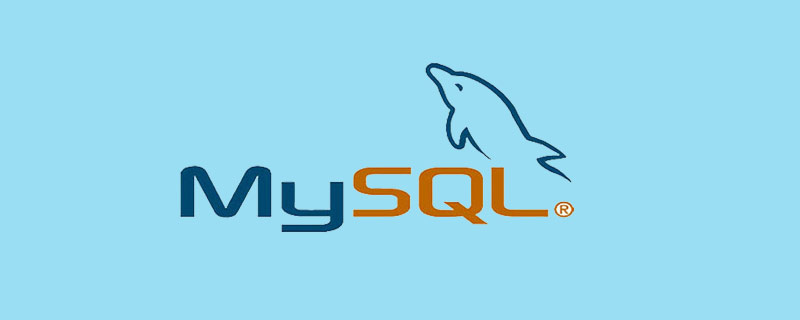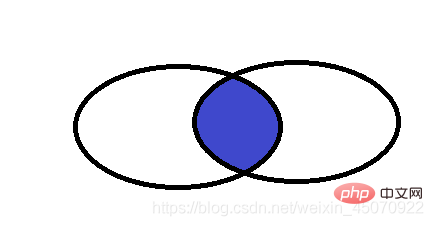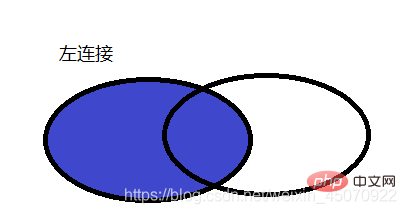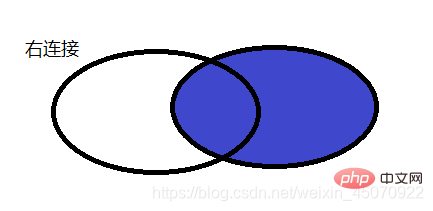 Database
Database
 Mysql Tutorial
Mysql Tutorial
 Detailed explanation of MySQL union query (the difference between IN and EXISTS)
Detailed explanation of MySQL union query (the difference between IN and EXISTS)
Detailed explanation of MySQL union query (the difference between IN and EXISTS)

Cartesian product
The Cartesian product refers to the Cartesian product of two sets X and Y in mathematics. Cartesian product, also known as direct product, is expressed as X × Y. The first object is a member of X and the second object is one member of all possible ordered pairs of Y [3].
Assume that set A={a, b} and set B={0, 1, 2}, then the Cartesian product of the two sets is {(a, 0), (a, 1), (a, 2 ), (b, 0), (b, 1), (b, 2)}.
Related free learning recommendations: mysql video tutorial
Inner connection
select 字段 from 表1 别名1 [inner] join 表2 别名2 on 连接条件 and 其他条件;select 字段 from 表1 别名1,表2 别名2 where 连接条件 and 其他条件;

Outer join
Outer join is divided into left outer join and right outer join. If a joint query is performed, if the table on the left is completely displayed, we say it is a left outer join; if the table on the right is completely displayed, we say it is a right outer join.
--左外连接,表1完全显示select 字段名 from 表名1 left join 表名2 on 连接条件;-- 右外连接,表2完全显示select 字段 from 表名1 right join 表名2 on 连接条件;


Self-connection
When it comes to comparisons between rows, you need to Connected
Example: Display all grade information with higher "Computer Principles" than "Java" grades
-- 先查询“计算机原理”和“Java”课程的idselect id,name from course where name='Java' or name='计算机原理';-- 再查询成绩表中,“计算机原理”成绩比“Java”成绩 好的信息SELECTs1.*FROMscore s1,score s2WHEREs1.student_id = s2.student_idAND s1.score <pre class="brush:php;toolbar:false">-- 也可以使用join on 语句来进行自连接查询SELECTs1.*FROMscore s1JOIN score s2 ON s1.student_id = s2.student_idAND s1.score <p><strong>Subquery</strong></p><p>The subquery refers to the subquery embedded in Select statements in other SQL statements are also called nested queries. <br> Single row subquery: Subquery that returns one row of records <br> Case: Query and "Xiaobai"'s classmates: </p><pre class="brush:php;toolbar:false">select * from student where classes_id=(select classes_id from student wherename='小白');
Multiple row subquery: Subquery that returns multiple rows of records
- [NOT] IN keyword:
First execute the SQL of the subquery, put the result into the memory, then perform the outer query, and directly put the given result Just compare the restriction conditions with the results of the subquery and filter them. (Depends on memory, suitable for situations where the result set of a subquery is relatively small) - [NOT] EXISTS keyword:
Execute the outer query first, take the records of each outer query in turn, and bring them into In the inner query
If the result set of the inner query is not empty, keep the results of the outer query
If the result set of the inner query is empty, discard the results of the outer query
Does not rely on memory, suitable for situations where the outer query result set is small and the subquery result set is relatively large
Merge query
For To merge the execution results of multiple selects, you can use the set operators union and union all. When using UNION
and UNION ALL, the fields in the result sets of the previous and subsequent queries need to be consistent.
union
This operator is used to obtain the union of two result sets. When this operator is used, duplicate rows in the result set are automatically removed.
Case: Query the courses with ID less than 3, or the name is "English":
select * from course where id<p><strong>union all</strong><br> This operator is used to obtain the union of two result sets . When this operator is used, duplicate rows in the result set are not removed. <br> Case: Query courses with ID less than 3, or with the name "Java": </p><pre class="brush:php;toolbar:false">-- 可以看到结果集中出现重复数据Javaselect * from course where id<blockquote><p><strong>Related free learning recommendations: </strong><a href="https://www.php.cn/course/list/51.html" target="_blank"><strong>mysql database</strong></a><strong>(video)</strong></p></blockquote>
The above is the detailed content of Detailed explanation of MySQL union query (the difference between IN and EXISTS). For more information, please follow other related articles on the PHP Chinese website!

Hot AI Tools

Undresser.AI Undress
AI-powered app for creating realistic nude photos

AI Clothes Remover
Online AI tool for removing clothes from photos.

Undress AI Tool
Undress images for free

Clothoff.io
AI clothes remover

AI Hentai Generator
Generate AI Hentai for free.

Hot Article

Hot Tools

Notepad++7.3.1
Easy-to-use and free code editor

SublimeText3 Chinese version
Chinese version, very easy to use

Zend Studio 13.0.1
Powerful PHP integrated development environment

Dreamweaver CS6
Visual web development tools

SublimeText3 Mac version
God-level code editing software (SublimeText3)

Hot Topics
 1378
1378
 52
52
 MySQL: Simple Concepts for Easy Learning
Apr 10, 2025 am 09:29 AM
MySQL: Simple Concepts for Easy Learning
Apr 10, 2025 am 09:29 AM
MySQL is an open source relational database management system. 1) Create database and tables: Use the CREATEDATABASE and CREATETABLE commands. 2) Basic operations: INSERT, UPDATE, DELETE and SELECT. 3) Advanced operations: JOIN, subquery and transaction processing. 4) Debugging skills: Check syntax, data type and permissions. 5) Optimization suggestions: Use indexes, avoid SELECT* and use transactions.
 How to open phpmyadmin
Apr 10, 2025 pm 10:51 PM
How to open phpmyadmin
Apr 10, 2025 pm 10:51 PM
You can open phpMyAdmin through the following steps: 1. Log in to the website control panel; 2. Find and click the phpMyAdmin icon; 3. Enter MySQL credentials; 4. Click "Login".
 How to create navicat premium
Apr 09, 2025 am 07:09 AM
How to create navicat premium
Apr 09, 2025 am 07:09 AM
Create a database using Navicat Premium: Connect to the database server and enter the connection parameters. Right-click on the server and select Create Database. Enter the name of the new database and the specified character set and collation. Connect to the new database and create the table in the Object Browser. Right-click on the table and select Insert Data to insert the data.
 MySQL and SQL: Essential Skills for Developers
Apr 10, 2025 am 09:30 AM
MySQL and SQL: Essential Skills for Developers
Apr 10, 2025 am 09:30 AM
MySQL and SQL are essential skills for developers. 1.MySQL is an open source relational database management system, and SQL is the standard language used to manage and operate databases. 2.MySQL supports multiple storage engines through efficient data storage and retrieval functions, and SQL completes complex data operations through simple statements. 3. Examples of usage include basic queries and advanced queries, such as filtering and sorting by condition. 4. Common errors include syntax errors and performance issues, which can be optimized by checking SQL statements and using EXPLAIN commands. 5. Performance optimization techniques include using indexes, avoiding full table scanning, optimizing JOIN operations and improving code readability.
 How to create a new connection to mysql in navicat
Apr 09, 2025 am 07:21 AM
How to create a new connection to mysql in navicat
Apr 09, 2025 am 07:21 AM
You can create a new MySQL connection in Navicat by following the steps: Open the application and select New Connection (Ctrl N). Select "MySQL" as the connection type. Enter the hostname/IP address, port, username, and password. (Optional) Configure advanced options. Save the connection and enter the connection name.
 How to recover data after SQL deletes rows
Apr 09, 2025 pm 12:21 PM
How to recover data after SQL deletes rows
Apr 09, 2025 pm 12:21 PM
Recovering deleted rows directly from the database is usually impossible unless there is a backup or transaction rollback mechanism. Key point: Transaction rollback: Execute ROLLBACK before the transaction is committed to recover data. Backup: Regular backup of the database can be used to quickly restore data. Database snapshot: You can create a read-only copy of the database and restore the data after the data is deleted accidentally. Use DELETE statement with caution: Check the conditions carefully to avoid accidentally deleting data. Use the WHERE clause: explicitly specify the data to be deleted. Use the test environment: Test before performing a DELETE operation.
 How to use single threaded redis
Apr 10, 2025 pm 07:12 PM
How to use single threaded redis
Apr 10, 2025 pm 07:12 PM
Redis uses a single threaded architecture to provide high performance, simplicity, and consistency. It utilizes I/O multiplexing, event loops, non-blocking I/O, and shared memory to improve concurrency, but with limitations of concurrency limitations, single point of failure, and unsuitable for write-intensive workloads.
 MySQL: An Introduction to the World's Most Popular Database
Apr 12, 2025 am 12:18 AM
MySQL: An Introduction to the World's Most Popular Database
Apr 12, 2025 am 12:18 AM
MySQL is an open source relational database management system, mainly used to store and retrieve data quickly and reliably. Its working principle includes client requests, query resolution, execution of queries and return results. Examples of usage include creating tables, inserting and querying data, and advanced features such as JOIN operations. Common errors involve SQL syntax, data types, and permissions, and optimization suggestions include the use of indexes, optimized queries, and partitioning of tables.



